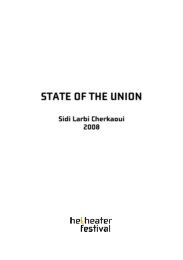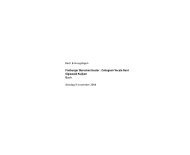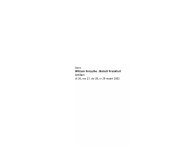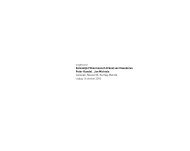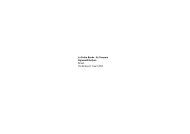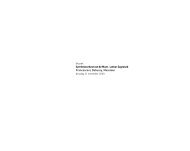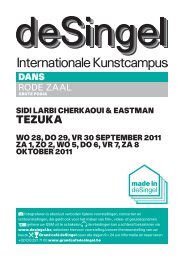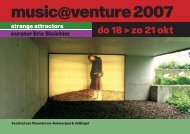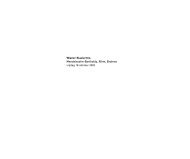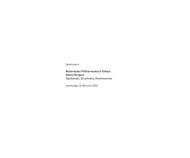Programmaboekje : Wonen in welvaart - deSingel
Programmaboekje : Wonen in welvaart - deSingel
Programmaboekje : Wonen in welvaart - deSingel
Create successful ePaper yourself
Turn your PDF publications into a flip-book with our unique Google optimized e-Paper software.
10)<br />
The habipat<br />
Liv<strong>in</strong>g <strong>in</strong> a plastic-mal<br />
The arrival of plastics at home was a symbol for the postwar<br />
welfare of the sixties. Synthetic material was also the basic material<br />
for new hous<strong>in</strong>g types. The Belgian professor Patfoort developed<br />
a procedure that could create <strong>in</strong> a mere 20 hours a cell of 40m²<br />
<strong>in</strong> hard synthetic. Connect<strong>in</strong>g various cells and plac<strong>in</strong>g w<strong>in</strong>dows<br />
<strong>in</strong> them created the ‘habipat-houses’. Patfoort was conv<strong>in</strong>ced<br />
they would solve the worldwide hous<strong>in</strong>g shortage and thus<br />
spread welfare. Patfoort put a lot of effort <strong>in</strong> the adaptation<br />
of his universal model by local <strong>in</strong>habitants. He <strong>in</strong>volved them <strong>in</strong><br />
production (self-help hous<strong>in</strong>g) and boosted the decoration of the<br />
cells with traditional materials.<br />
The United Nations funded a fi rst experiment <strong>in</strong> Chile <strong>in</strong><br />
1972. Later, the habipat-sytem was applied for temporary<br />
accommodations after earthquakes or to replace slums. But usually<br />
temporary became eternally, until today people live <strong>in</strong> habipats.<br />
The 1973 oil crisis put an end to the belief <strong>in</strong> synthetics as a<br />
solution for worldwide hous<strong>in</strong>g shortage.<br />
The documents on display come from Patfoort‘s personal archives<br />
and illustrate how postwar hous<strong>in</strong>g is preserved at private care.<br />
(research: Tom Avermaete and Kar<strong>in</strong>a Van Herck)<br />
translation: Andreas Provo<br />
Catalogue<br />
An abundantly illustrated book <strong>in</strong>clud<strong>in</strong>g sixteen essays about<br />
postwar hous<strong>in</strong>g is be<strong>in</strong>g published together with the exhibition.<br />
The book alternates articles opf concrete case studies with<br />
refl ective pieces about postwar hous<strong>in</strong>g by Geert Bekaert,<br />
Hilde Heynen and Bruno De Meulder. A conversation between<br />
Ed Taverne and Bruno De Meulder about the similarities and<br />
differences between Flanders and the Netherlands concludes the<br />
book.<br />
‘<strong>Wonen</strong> <strong>in</strong> Welvaart. Won<strong>in</strong>gbouw en wooncultuur <strong>in</strong> Vlaanderen, 1948-1973’<br />
edited by Kar<strong>in</strong>a Van Herck and Tom Avermaete, 010 Publishers, Rotterdam<br />
320 pag<strong>in</strong>a’s, Dutch<br />
€ 34,50<br />
16 17



